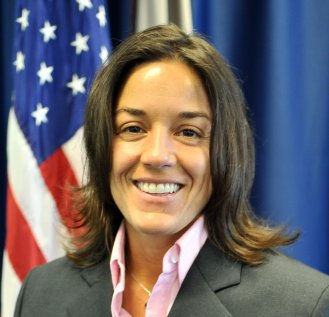Working for justice
At any given time, U.S. Attorney Jacqueline Romero ’93 handles more than 20 cases, but one particularly complex case about gold coins recently landed her in the national news.


Jacqueline Romero ’93 knew early on that one day she would pursue law. When she was about five-years-old, she declared at Thanksgiving dinner that she would be a judge when she grew up. The youngest of five children and the first in her family to graduate from a four-year college, Romero said she always had a sense of justice because there wasn’t any in a family that big. “I have never liked bullies,” she says, “I’ve always been the kid in school who stuck up for other people.”
Romero hasn’t landed a judgeship yet, but she has made a career of upholding the Constitution as an assistant U.S. attorney in Philadelphia. At any given time, she handles more than 20 cases, but one particularly complex case about gold coins recently has landed her in the national news.
The case involves 10 Double Eagles—among about half a million such coins made by the U.S. Mint in 1933 that were never legally issued and are estimated to be worth millions of dollars each. They were discovered in the safe deposit box of the family of the late Philadelphia jeweler Israel Switt after his death. Romero and the U.S. Attorney’s office in July won a case proving that Switt, who had been the subject of an intense Secret Service investigation in the 1940s, had had a hand in steeling the gold coins. The Secret Service believed that Switt had acquired them through a corrupt Mint cashier but due to the statute of limitations was never able to prosecute him. The Secret Service’s “conclusion [was] that every single 1933 Double Eagle that they can find in private hands traces back to Israel Switt,” said Romero.
Lawyers for Switt’s daughter, Joan Langbord, claim that she didn’t know how her father acquired the coins and she didn’t know they were in the safety deposit box until 2004, when her attorney arranged a meeting with the U.S. Mint and voluntarily handed them over. The government seized the coins. The U.S. Mint claimed they belonged to the U.S. government and the Langbords were not entitled to them; the Langbord family disagreed and eventually filed a lawsuit in 2006.
That’s when Romero got involved. A court ordered the government to prove that a crime occurred in the 1930s. When the case came across Romero’s supervisor’s desk in October 2006, she knew exactly who to hand it over to—Romero, who had worked as a senior counsel for the U.S. Mint. Her knowledge of how coins are made, and the paper trails and process involved, helped her in preparing the case.
Romero scoured national archives from Philadelphia to Georgia for any documents from the 1930s related to the case. She unearthed manufacturing records of the coins, the U.S. Mint’s daily cashier’s statements, and correspondence from coin dealers. Through the evidence, she connected the dirty cashier to Switt.
Although a jury ruled that a theft had occurred and the U.S. Treasury was correct in seizing the coins, the case isn’t over. Romero is expecting appeals. Romero’s office also filed a request for the judge who presided over the trial to rule on who owns the coins. That decision is expected in November.

Today the coins are at Fort Knox, where they should be, Romero said. “These belong to you and me. They don’t belong to the Langbord family. And they should be on display for the benefit of the people of the United States.”
In addition to the 1933 Double Eagle case, her docket includes defending the government against civil rights violations and employer discrimination cases and prosecuting environmental enforcement matters and, last year, the pharmaceutical company Novartis for off-label marketing.
An English major and political science minor at TCNJ, Romero credits her journalism and writing professor, Kim Pearson, for instilling in her a sense of thoroughness—a valuable quality for an attorney. From Pearson, she learned to follow up on ideas and developed a sense of diligence about uncovering information—which serves her today in investigations.
An associate professor of English, Pearson saw in Romero not only a talented and conscientious student, but also someone who was thinking strategically about her future, had good networking skills, and was active in the campus community. Romero was involved in Latino and African-American organizations. “I could easily see her following in the footsteps of [U.S. Supreme Court Justice] Sonia Sotomayor,” says Pearson, who went to college with Sotomayor. Romero “has that kind of intellect and that kind of grit.”
After college, Romero earned a law degree at Rutgers and then worked for a law firm in Roseland, NJ, where she gained trial experience through pro-bono cases involving termination of parental rights cases. Later she joined the Justice Department in Washington, DC, before moving to the Treasury.
But it’s not all work and no play for Romero: she’s working on the Great American Novel, is an avid runner, paints, and plays blues guitar. She also was a member of the Maryland Women’s Rugby Football Club for seven years and a member of the U.S. women’s Olympic handball team in 2001.
As an assistant U.S. attorney she puts in long hours, making it difficult at times to balance home and work life. But there’s a payoff: “There’s something to be said for being in service to one’s nation,” says Romero. “I can’t say we always get it right, but … we’re sworn to do fairness and justice and that means something.”
Posted on October 13, 2011

